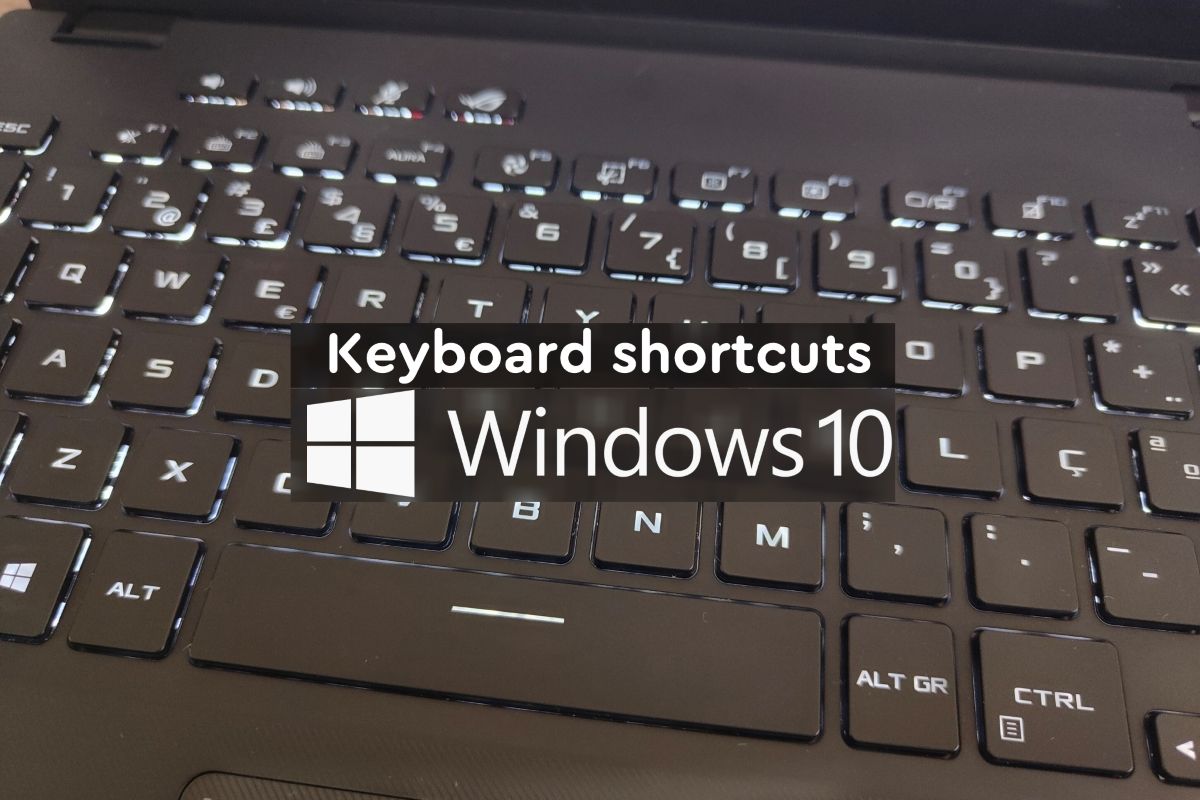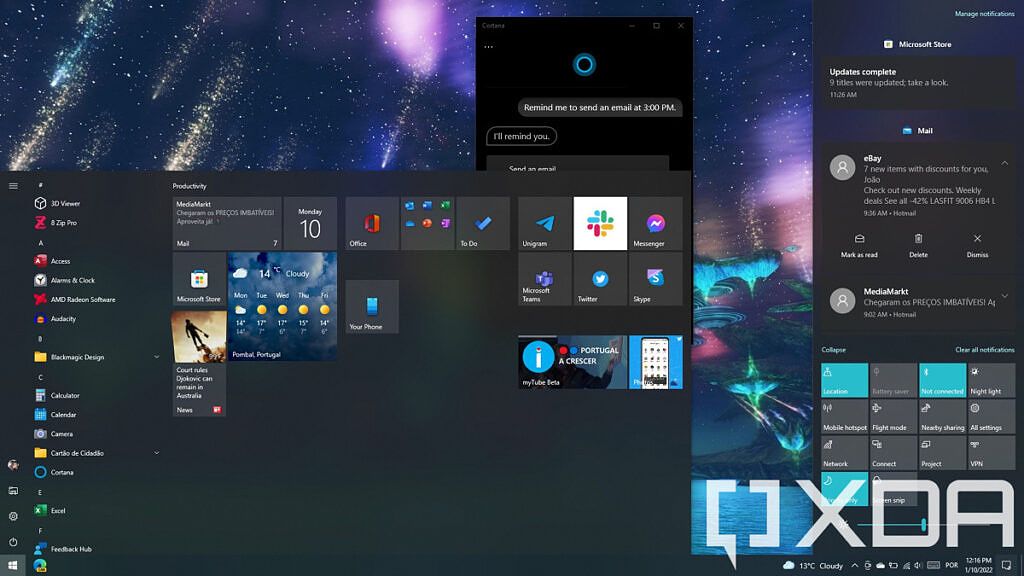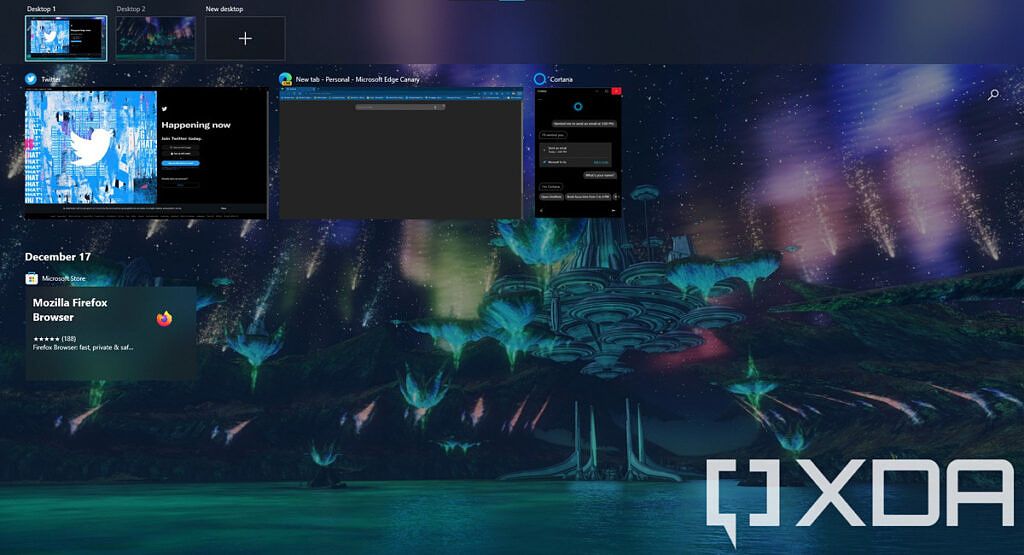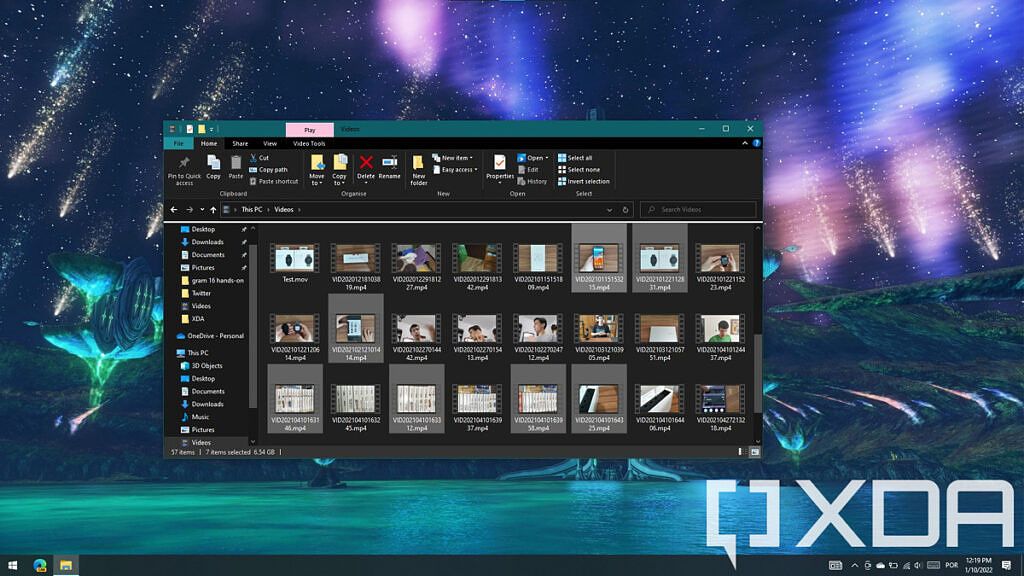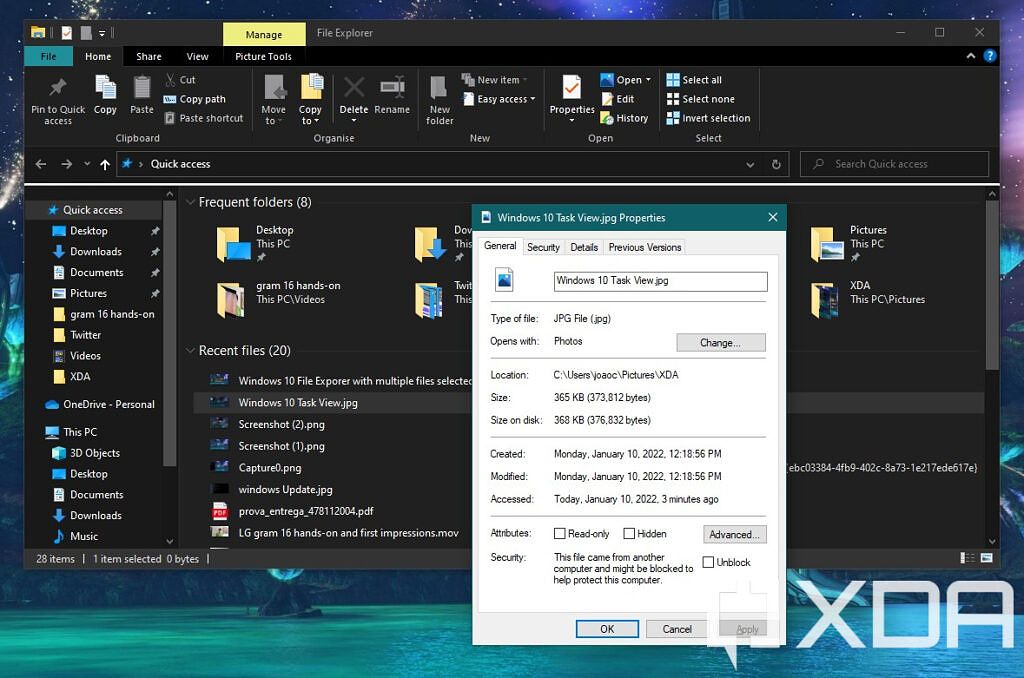For the majority of people, using a computer with a keyboard and mouse is the most natural way to do this. It's just how most modern computers are designed to be used, and in general it can be more intuitive. Using a mouse lets you easily see and point at the things you want to click, open, or move, so anyone can pick it up and understand how it works. But for proficient users, the keyboard alone can sometimes be a more powerful tool. In this guide, we'll show you all the keyboard shortcuts you can use in Windows 10 to get things done faster.
There's quite a lot you can do with just a keyboard that you might not know about. Whether it's something as simple as copying text to opening apps and certain features, you might find yourself using your keyboard a lot more after reading this guide.
Navigate this article:
- Shortcuts for Windows 10 features and apps
- Shortcuts for multitasking and window management
- Shortcuts for File Explorer
- Shortcuts for dialog boxes
- Shortcuts for the taskbar
- Other general shortcuts (text, navigation, etc)
Keyboard shortcuts for Windows 10 features and apps
You may know the Windows key on your keyboard for opening the Start menu throughout the years, but did you know you can combine it with other keys to do a whole lot more? Here are a few shortcuts that use the Windows key to launch features and apps, plus a few others.
- Windows key + A - Open the Action Center. This displays or notifications along with quick action toggles for Wi-Fi, Bluetooth, Focus Assist, and more.
- Windows key + C - Launch Cortana, the digital assistant built into Windows 10. You can type questions and other queries to get help from Cortana, or configure Cortana to start listening for your voice when you use the shortcut.
- Windows key + D - Show or hide the desktop. Showing the desktop hides all your open windows and apps, and pressing the keyboard shortcut again restores the windows in their correct place.
- Windows key + Alt + D - Display the time and calendar flyout.
- Windows key + E - Open File Explorer.
- Windows key + F - Take a screenshot and open Feedback Hub. This lets you more easily send feedback to Microsoft about a problem you may have encountered.
-
Windows key + G - Open the Xbox Game Bar. This lets you record videos, take screenshots, and access various features while playing a game.
- Windows key + Alt + B - Turn HDR on or off. This requires an HDR-compatible monitor and a recent version of the Xbox Game Bar app.
- Windows key + Alt + R - Start recording a video of your app or game using the Xbox Game Bar.
- Windows key + H - Launch dictation, allowing you to enter text using your voice instead of typing. This is only available in select languages.
-
Windows key + I - Open the Settings app.
- Windows key + Pause - Open the About page in Settings. This includes information about your computer hardware and Windows itself.
-
Windows key + U - Open the Accessibility Settings page.
- Windows key + Ctrl + C - Turn color filters on or off. This feature needs to be enabled in the Accessibility settings first (in the Color Filters tab), and it lets you change how colors are displayed to account for various forms of color blindness.
- Windows key + K - Open the Connect pane, allowing you to connect to wireless displays that support Miracast, as well as other wireless devices such as Bluetooth.
- Windows key + L - Lock your PC. This keeps all your apps open, but requires you to unlock your PC before using them again.
-
Windows key + M - Minimize all your windows.
- Windows key + Shift + M - Restore your minimized windows. This only works if you haven't opened any windows in the meantime.
- Windows key + O - Lock device orientation. For tablets and convertibles, this prevents the display from rotating when you rotate your PC.
- Windows key + P - Change the display mode for multiple monitors. If you have multiple displays connected, you can choose whether to use your screens as extensions to each other, duplicate them, or use only a single screen at a time.
- Windows key + Ctrl + Q - Open Quick Assist. This is a tool that allows you to provide assistance to another Windows user remotely by seeing their screen or taking control of their PC.
- Windows key + R - Open the Run dialog. This allows you to open any app on your PC, as long as you know the name of the executable file for the app.
- Windows key + S or Windows key + Q - Open Windows Search. You can search for files, apps, and search the web here.
- Windows key + Shift + S - Take a screenshot using the Snip & Sketch. After pressing the keys, you can choose your preferred capture mode, including free form, rectangle, window, and full-screen (this includes all connected monitors).
- Windows key + V - Open your clipboard history. This allows you to see multiple items you've copied, including text, links, and images. This feature is initially disabled, but you can also enable it in this window.
- Windows key + X - Open the Quick Link menu, which is equivalent to right-clicking the Start icon on your taskbar. This contains links to system features like Settings, File Explorer, Task Manager, and more.
- Windows key + Y (Windows Mixed Reality devices only) - Switch input between Windows Mixed Reality and the desktop.
- Windows + . (period) or ; (semi-colon) - Open the emoji panel. This lets you add emoji to any text field.
- Windows + , (comma) - Temporarily look at the desktop. Your desktop is only visible as long as you hold one of the keys after pressing them, then your windows are restored.
- Windows key+ Ctrl + F- Search for PCs on your network. This is meant for Azure Active Directory domains.
-
Windows key + Spacebar - Cycle between languages and input methods (if multiple are installed).
- Windows key + Shift + Spacebar - Cycle backwards through the list.
- Windows key + Ctrl + Spacebar - Switch to the last used input method.
- Ctrl + Shift - Switch to a different keyboard layout if multiple are available (for the same language).
- Ctrl + Spacebar - Turn the Chinese IME on or off (if the Chinese language is installed).
- Windows key + Ctrl+ Enter - Turn on Narrator. This accessibility feature reads on-screen elements to make navigation easier for those with vision impairments.
-
Windows key + + (plus) - Turn on the Magnifier and zoom into the screen.
- Windows key + - (minus) - Zoom out with the Magnifier.
- Windows key + Esc - Close the Magnifier.
- Windows key + / (forward slash) - Begin IME reconversion.
- Windows key + Ctrl + Shift + B - Wake up your PC from a blank or black screen.
-
Windows key + PrtScn(Print Screen, may be represented differently on different keyboards) - Take a full-screen screenshot and automatically save it to a file. Items are saved in the Pictures library in a folder called Screenshots.
- Windows key + Alt+ PrtScn - Take a screenshot of the active game or window and save it into a file. This feature uses the Xbox Game Bar, and files are saved in the Videos library, in a folder called Captures (by default).
- PrtScn - Take a full-screen screenshot and copy it to the clipboard, so you can paste it somewhere else without saving it as a file. You can also go to the Settings app > Accessibility > Keyboard to set the PrtScn key to open the Snipping Tool (making it the same as Windows key + Shift + S)
-
Ctrl + Esc - Open the Start menu.
- Ctrl + (arrow) - Resize the Start menu (when it's open)
- Alt + Shift + (arrow) - When focus is set to a tile on the Start menu, move the tile in the direction of the arrow.
- Ctrl + Shift + (arrow) - When focus is set to a tile, move it into the next tile to create a folder.
- Ctrl + Shift + Esc - Open the Task Manager.
Keyboard shortcuts for multitasking and window management
Juggling multiple apps and windows at the same time can be troublesome, and the mouse isn't always the fastest way to find the app you want. These keyboard shortcuts help you switch between apps, resize windows, or snap them next to each other in Windows 10.
- Windows key + Tab - Open Task View. This displays all your open apps as tiles so you can choose one to focus on. It also displays your virtual desktops and your timeline, including previously open apps and documents.
-
Alt + Tab - Switch to your last active window. Press Tab repeatedly while holding Alt to choose what window to switch to.
- Alt + Esc - Cycle through windows in the order in which they were opened.
- Ctrl + Alt + Tab - View all your open apps so you can choose one with the keyboard arrows. This is similar to Task View, but doesn't display your virtual desktops and is only visible in your current active monitor.
- Alt + F4 - Close the active window or app. If used on the desktop, this opens the Windows power menu.
- Windows key + Up arrow - Maximize the active window so it takes up the entire desktop.
- Windows key + Down arrow - Set the active window to a smaller size if it's maximized. Hide the window into the taskbar if it's not maximized.
- Windows key + Left arrow - Snap the active window to the left half of the screen.
-
Windows key + Right arrow - Snap the active window to the right half of the screen.
- If you hold down the Windows key after snapping an app to half the screen, you can use one of the other arrows to snap the app into a quarter of the screen. You can also press the same arrow repeatedly to move windows to different monitors (still taking up half the screen).
- Windows key + Home - Minimize all windows except the active window. Press again to restore the minimized windows.
- Windows key + Shift + Up arrow - Stretch the active window to take up the entire vertical space, keeping the same width (for non-maximized windows). The same shortcut with the Down arrow reverses this.
- Windows key + Shift + Right arrow or Left arrow - Move the active window to a different monitor.
- Windows key + Ctrl + D - Create a new virtual desktop
- Windows key + Ctrl + Left arrow or Right arrow - Switch between virtual desktops to the left or right.
- Windows key + Ctrl + F4 - Close the current virtual desktop. Any open apps are moved to the next virtual desktop in line.
File Explorer keyboard shortcuts in Windows 10
The File Explorer is one of the core features of Windows, allowing you to see and manage all the files stored on your PC. There are a few shortcuts you can use to make this experience easier and faster using a keyboard instead of a mouse.
- Alt + D - Set focus to the address bar.
- Ctrl + E or Ctrl + F or F3 - Set focus to the search bar.
- Ctrl + N - Open a new window (also works in some web browsers)
- Ctrl + W - Close the active window (this can also be used to close the active tab in web browsers).
- Ctrl + mouse scroll wheel - Change the size of folder and file icons. Scrolling up makes icons bigger, scrolling down makes them smaller.
- Ctrl + Shift + N - Create a new folder.
-
Ctrl + Shift + E - Displays all the folders in the parent directory of the current active folder (by expanding the list on the sidebar) if the current folder has no sub-folders.
- Num lock + * (asterisk) or + (plus) - Display all the subfolders in the current selected folder on the siderbar.
- Num lock + - (minus) - Collapse an expanded folder.
- Alt + Enter - View properties of the selected file or folder.
- Alt + P - Show the preview panel.
- Alt + Left arrow or Backspace - Go back one page (also works in some apps like web browsers)
- Alt + Right arrow - Go forward one page (also works in apps like web browsers)
- Alt + Up arrow - View the parent folder of the current active folder.
-
Ctrl + (arrow) - Navigate the items in the current page without selecting them.
- Ctrl + Spacebar - Select individual items while navigating
- Shift + (arrow) - Select consecutive items starting from the currently selected one. In grid-style layouts, the up and down arrows select entire rows of items. If you start moving in the opposite direction, the last selected item(s) is/are deselected.
-
Right arrow (on navigation sidebar) - Expand a collapsed folder or switch to the first subfolder of an expanded folder.
- Left arrow - Collapse an expanded folder or select the parent folder of the currently selected one.
- Home - Go to the top of the current page (works in various other apps).
- End - Go to the bottom of the current page (also works in multiple apps).
- F2 - Rename the selected file or folder.
- F4 - Display the address bar list in File Explorer.
Keyboard shortcuts for dialog boxes
Dialog boxes are small windows apps can sometimes generate to present menu options and settings. There are a few keyboard shortcuts specifically meant for dialog boxes, but they can vary quite a bit depending on how complex the dialog box is. Here are some of the keyboard shortcuts you can use in these dialog boxes.
- F4 or Spacebar- Display items in an active dropdown list.
- Arrow keys - Select a button in a group of buttons or option in a list.
- Spacebar - Select or deselect an active item if it's a checkbox.
-
Ctrl + Tab - Switch through different tabs (also works in web browsers)
- Ctrl + Shift + Tab - Switch backwards through tabs
-
Tab - Move through options on the current page
- Shift + Tab - Move backward through the options on the current page.
- Alt + (letter) - Select the option with the corresponding underlined letter in its description.
Windows 10 taskbar shortcuts
The taskbar is another central part of Windows 10, and while many of us would usually interact with it using a mouse, you can do it with keyboard shortcuts. But in some cases, you can also use the keyboard as an assistant to the mouse to make certain actions quicker.
- Windows key + T - Cycle focus through apps on the taskbar (open or pinned). You can then select them by pressing Enter.
- Windows key + (number) - Start the app pinned to the taskbar in the position indicated by the number. If the app is already running, switch to that app. If an app has multiple instances open, you can hold the Windows key and press the same number again to switch to a specific instance of the app.
-
Windows key + Shift + (number) - Start a new instance of the app pinned to the taskbar in the position indicated by the number, even if one is already open.
- Windows key + Ctrl + Shift + (number) - Open a new instance of the app located at the given position on the taskbar as an administrator.
- Windows key + Ctrl + (number) - Switch to the last active window of the app pinned to the taskbar in the position indicated by the number.
- Windows key + Alt + (number) - Open the Jump List for the app pinned to the taskbar in the position indicated by the number.
- Shift + left mouse click - Open a new instance of the selected app.
- Ctrl + Shift + left mouse click - Open the selected app as an administrator.
- Shift + right mouse click - Open the window menu for the selected app
- Ctrl + left mouse click (on an app with multiple windows open) - Cycle through the open windows for the app
- Windows key + B - highlight the first icon in the notification tray area. This allows you to navigate the icons with the arrow keys and select them with Enter.
General keyboard shortcuts in Windows 10
Beyond specific Windows 10 features, many keyboard shortcuts are available throughout the operating system and its apps. This can include things like copying text and items, navigation menus, and so on, but support for these features in apps can vary.
- Ctrl + A - Select all text or items in a document, page, or window.
- Ctrl + D - Delete the selected text or item(s).
- Ctrl + X - Cut the selected item or text.
- Ctrl + C - Copy the selected item or text.
- Ctrl + V - Paste copied or cut content from the clipboard.
- Ctrl + Z - Undo your last action.
- Ctrl + Y - Redo an undone action.
-
F5 or Ctrl + R - Refresh the active window or page (works in various apps, including web browsers).
- Ctrl + F5 - In some web browsers, this refreshes the active window by forcing the browser to reload files even if they've previously been cached. This can help if changes have been made to a page but you're unable to see them in your browser.
- F6 - Cycle through screen elements of the active window or desktop.
- F10 - Activate the menu bar in the active window or app.
- Alt + F8 - Show your password on the Windows sign-in screen
- Alt + (letter) - When menus are being displayed, select the option with the corresponding underlined letter in the text.
-
Alt + Spacebar - Open the shortcut menu for the active window.
- Shift + F10 - Open the shortcut/context menu for the selected item.
-
Left arrow (in menus) - Move to the left on the menu, or close an open sub-menu.
- Right arrow (in menus) - Move to the right on the menu, or open a selected sub-menu.
- Ctrl + F4 - Close the open document or tab in apps that allow you to open multiple documents or tabs at once, such as web browsers.
- Ctrl + E - Open search (in some apps).
-
Ctrl + Right arrow - In a document, move the text cursor to the beginning of the next word.
- Ctrl + Left arrow - Move the text cursor to the beginning of the previous word.
-
Ctrl + Up arrow - In a document, move the text cursor up one paragraph.
- Ctrl + Down arrow - Move the text cursor down one paragraph.
- Alt + Shift + (arrow key) - When focus is set to a pinned app in the Start menu, move the pinned app in the direction of the arrow.
-
Shift + (arrow key) - In a document, select text starting from the position of the text cursor.
- Left arrow - Select the previous character. Right arrow deselects the last selected text.
- Right arrow - Select the next character. Left arrow deselects the last selected text.
- Up arrow - Select the previous line. Down arrow deselects the last selected line.
- Down arrow - Select the next line. Up arrow deselects the last selected line.
-
Ctrl + Shift + (arrow key) - In a document, select a block of text starting from the position of the cursor:
- Left arrow - Select the previous word. Right arrow deselects the last selected text.
- Right arrow - Select the next word. Left arrow deselects the last selected text.
- Up arrow - Select the previous paragraph. Down arrow deselects the last selected paragraph.
- Down arrow - Select the next paragraph. Up arrow deselects the last selected paragraph.
- Esc - Stop or leave an ongoing task (use varies by app).
With these Windows 10 keyboard shortcuts in hand, you may find yourself your keyboard more than your mouse soon enough. The first instinct many may have is that this isn't as intuitive, but it can be very rewarding to learn all these shortcuts, as they save you a lot of time in the long run. For some of these shortcuts, specifically the ones based on the Windows key, Microsoft's PowerToys software includes a tool called Shortcut Guide. You can hold down the Windows key to see all the shortcuts available for it.
Windows 10 is still the most widely used operating system out there, but if you have upgraded to Windows 11, we have a guide for Windows 11 keyboard shortcuts, too. Most of them are the same across both operating systems, but a few have changed, and Windows 11 has a few new ones, too. Check out our Windows 11 review if you want to know whether you should upgrade or not.

